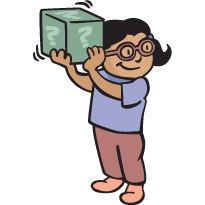Boston Children's Museum
308 Congress Street, Boston, MA 02210
617-426-6500
© Boston Children’s Museum 2025
Website Design by JackrabbitChildren’s bodies are undergoing constant change. By getting to know their own bodies better, these changes can be less mysterious. Children who are in tune with their own bodies can use all of their senses as tools as they explore and try to understand the world around them. This activity helps children learn more about their sense of hearing.
Choose 5 different small items to place in the sound cups. Try to choose objects made from different materials, like paper clips, corks, erasers, rice, small rubber balls, cotton balls, etc. You will need at least 10 of each item.
Make a set of 5 sound cups for each team. Place a different item in 5 separate cups (ex. a cotton ball in one cup, a paper clip in another, etc.). If using a material like rice, you can put several grains in a cup. Place a second cup, face down, on top of the first cup and tape these two cups together. You will have created an enclosed “rattle”—students can shake these sound cups and try to predict what is inside. Write a different number, from 1–5 on each cup. Make sure these numbers match for all of the sets of sound cups (ex. if sound cup #1 has a paper clip in it for one group, sound cup #1 should have a paper clip in it for every group). See Figure 1 for an illustration.

Ask your students to be very quiet and close their eyes. After 20 seconds, ask them if they noticed anything. What sense did they find themselves using most? If they say “hearing”, ask them what sorts of things they heard. Could they tell what was making the sounds just by hearing them?
Test your sound smarts with these sound cups!
After each team has recorded their predictions, bring the class together to talk about what they did. Was it easy or hard to predict what was in the cups? Were some objects easier to guess than others? Have each group share their predictions. Record these predictions on a piece of chart paper or a chalkboard. When every team has shared their guesses, invite them to open up the cups and see what is inside. Did anything surprise them?
After discussing the results, have students each take a sound cup, put an object from somewhere in the room in it, close it up and have their teammates try to predict what is inside.